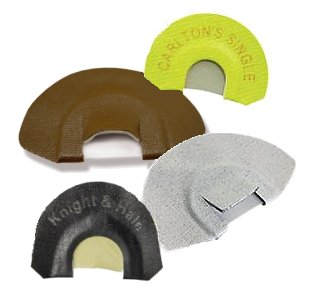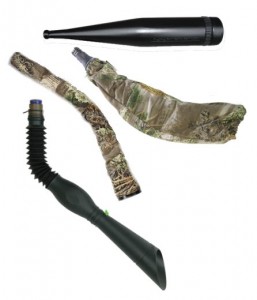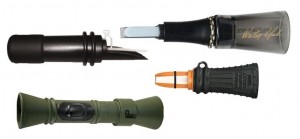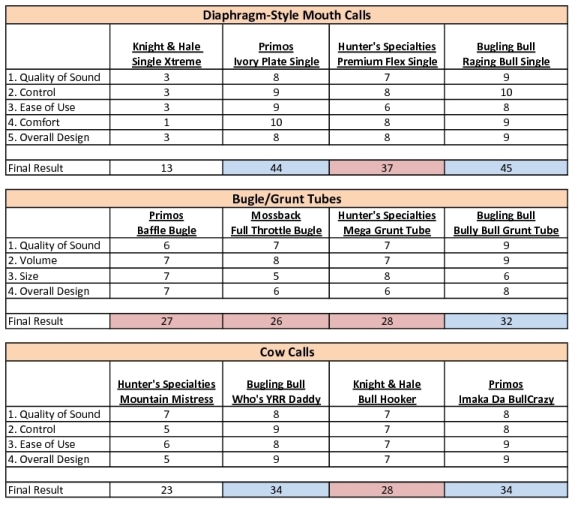When it comes to elk calls, determining which ones to buy can be more confusing and frustrating than finding a good pair of boots! Similarly, one elk call might fit one hunter better, while another call might be the best fit for someone else. To help in the selection process, we’ve assembled a collection of some of the most popular calls available on the market today, by some of the top elk call manufacturers, and put them through an unbiased, side-by-side test. Due to the fact that there are literally hundreds of options, you might not see your favorite elk call listed below.
We’ll start with the diaphragm-style mouth calls, then compare grunt tubes, and finish the comparison with the cow calls.
Diaphragms
 Many manufacturers offer diaphragm calls in a variety of sizes, shapes, and latex configurations. To keep it level, we’ll be testing only single-latex diaphragm calls as they are the easiest to use and learn to use. At the bottom of this page, you’ll find the results for this phase of the comparison based upon the following criteria:
Many manufacturers offer diaphragm calls in a variety of sizes, shapes, and latex configurations. To keep it level, we’ll be testing only single-latex diaphragm calls as they are the easiest to use and learn to use. At the bottom of this page, you’ll find the results for this phase of the comparison based upon the following criteria:
1. Quality of Sound – Just how closely does the call sound to an elk?
2. Control – How easy is it to hit the right notes at the right time?
3. Ease of Use – How easy is it to control air flow? How easy is it to make a sound? Is it easy to use out of the package?
4. Comfort – How does it feel in the mouth?
5. Overall Design – Does the manaufacturing lend itself towards a quality product?
Grunt Tubes
 Grunt tubes are designed to amplify the sound of your bugle to be able to reach greater distances, as well as add authenticity to your calls. Your style of hunting may have an influence on the style of bugle tube you use. For instance, if you are bivy hunting several miles from the nearest roads, you may want a smaller, more “packable” style grunt tube. If you are going for the most authentic elk sound you can create, one design might be better than another. To keep things consistent, we’ll be looking at the “main-stream” grunt tubes from some of the top elk call manufacturers and basing the results upon the following criteria:
Grunt tubes are designed to amplify the sound of your bugle to be able to reach greater distances, as well as add authenticity to your calls. Your style of hunting may have an influence on the style of bugle tube you use. For instance, if you are bivy hunting several miles from the nearest roads, you may want a smaller, more “packable” style grunt tube. If you are going for the most authentic elk sound you can create, one design might be better than another. To keep things consistent, we’ll be looking at the “main-stream” grunt tubes from some of the top elk call manufacturers and basing the results upon the following criteria:
1. Quality of Sound – Does the bugle sound like an elk? Does it sound like an elk bugling in a culvert?
2. Volume – The purpose of a grunt tube is to amplify your sounds…how well does the tube perform?
3. Size – Do I need a pack frame to haul the tube up the mountain?
4. Overall Design – Does the tube create the correct amount of back-pressure to maximize the quality of the diaphragm?
Cow Calls
 Lastly, we’ll take a look at cow calls. The most popular style of cow calls are the open-reed style calls, which is what we’ll be taking a look at here. Results will be based upon the following criteria:
Lastly, we’ll take a look at cow calls. The most popular style of cow calls are the open-reed style calls, which is what we’ll be taking a look at here. Results will be based upon the following criteria:
1. Quality of Sound – Des it sound like a bird or a cow elk?
2. Control – Does the call make a variety of cow sounds, or does it repeat the same call over and over?
3. Ease of Use – When your heart is pounding and you need to make the right call, are you going to need the instruction manual to get it done?
4. Overall Design – Does the reed stick to the sound board? Is the reed going to break in the middle of a set-up?
With the criteria set and the calls assembled, let’s get started!

